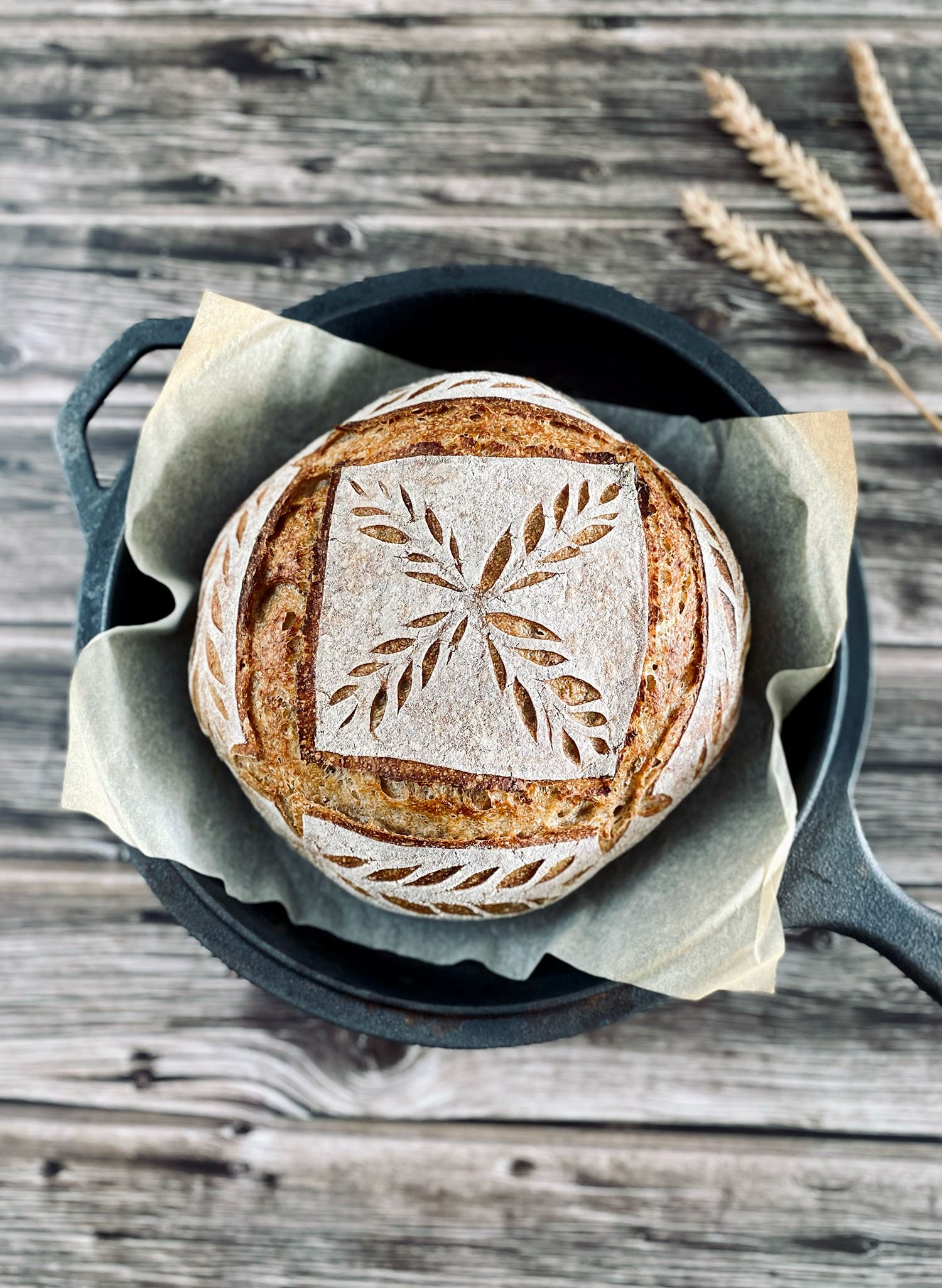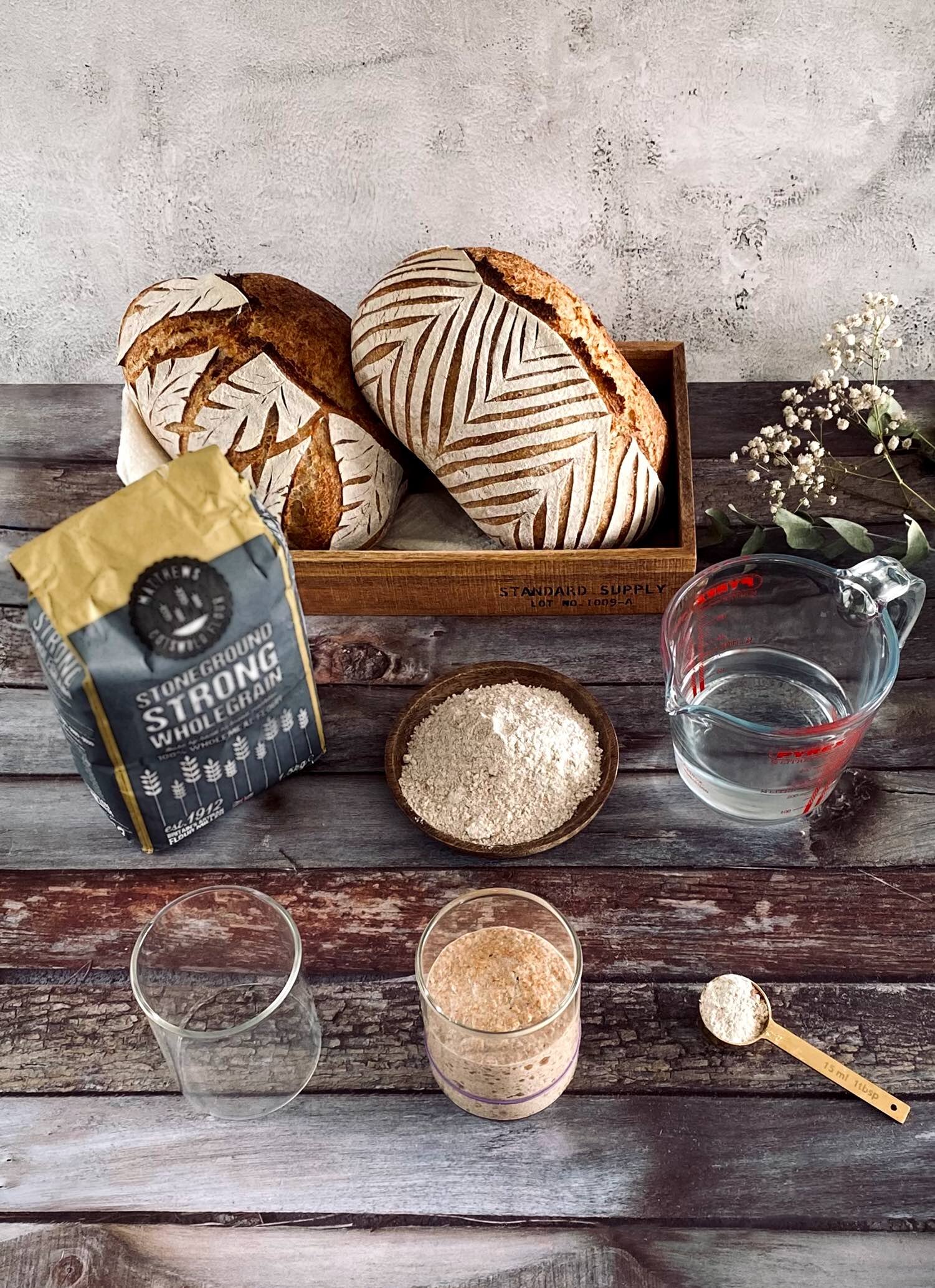
Sourdough Baking Tools
A list of the basic tools we recommend for your bread baking.
Medium-size jar (around 350ml)
This jar will be used to build your starter/levain required in your bread recipe. It needs to be big enough to hold the amount of the starter/levain specified in the recipe and also be big enough to allow room for your starter/levain to at least double the starting volume.
We’d recommend a clear glass jar with a lid, with straight walls and a wide opening.
Clear glass will be useful for you to see the content and quality of the starter (the bubbles). It will also allow you to assess how much the starter has risen (therefore when it’s ready to be used in your recipe). Many bakers place a rubber band around the jar to mark the ‘starting point’ or the ‘base line’ of the starter when the ingredients are just mixed together. The rubber band will help you monitor the volume increase over time.
The wide opening helps when adding and stirring the ingredients inside the jar. The straight walls of the jar will allow for an easy assessment of the increase in volume of the starter.
And one final point regarding the lid - you want your starter to ‘breathe’, so make sure the lid can be placed loosely on top of the jar.
Small-size jar (around 100ml)
The smaller jar is useful for storing your starter when you’re not baking. To help reduce waste (mainly of the flour used in the starter), you can keep just a very small amount of the starter and then build it up to the amount required in the recipe, when you bake your bread.
And you don’t necessarily need to buy a jar—for the purpose of storing your starter, you can simply use a small jam jar with a lid. Just make sure you place the lid loosely on top.
We’d recommend getting a couple of those smaller jars - it is good practice to change the jar with each feeding, otherwise cleaning it becomes a hassle. So having two of those means you’ll always have a clean one ready to use, when it’s time for feeding your starter again.
Digital scale
Because of the precision required when measuring ingredients for your sourdough bread recipe (or when feeding your starter), you’d ideally want to use a digital scale. Any variations to the amounts used may have an impact on the final bake—so if you don’t have one, get one!
We recommend the Brod & Taylor High-Capacity Baking Scale. It looks very modern, easy to clean, made of scratch-resistant tempered glass.
Cooking thermometer
Temperature is important when it comes to the water used for feeding or building your starter, as well as the temperature of the water that is added to the dough when making sourdough bread. The main impact here will be on the time required for the dough to ferment or for the starter to peak - it will take longer if the water is too cold for example. So cooking thermometer will help you control the timings more accurately.
For higher precision, we recommend a digital thermometer.
Bench knife (scraper)
We use a bench knife when handling/lifting the dough and when shaping it. Bench knife is also useful for cutting the dough before pre-shaping.
We recommend the Challenger Bench Knife. The streamlined walnut handle provides a comfortable grip, while the wide stainless steel blade gives you ample surface area to shape your dough.
Banneton/proofing basket
If there was one tool to recommend for sourdough making, a proofing basket will be the one to get.
There are various shapes and sizes of baskets available on the market, so make sure you get one that is the right size for your needs. If you have a Dutch oven, or are planning to buy one, make sure the size of the basket is appropriate for the dough to fit into the Dutch oven.
We use rattan baskets with and without the liner as well as baskets made of wood pulp. Both types are good, but they produce a slightly different finish. A basket without the liner will result in a dough with visible rims. The standard wood pulp basket creates more of a smooth finish.
For our Dutch oven (see dimensions in the section below), we use the following basket sizes (anything bigger will not fit into the dish).
Oval banneton (rough internal dimensions—top opening measured inside): 23 x 12.5 x 7.5 cm (Length x Width x Height) (9” x 5” x 3”)
Round banneton (rough internal dimensions—top opening measured inside): 20 x 8 cm (Diameter x Height) (8” x 3”)
If, at this stage, you are really unsure whether you want to invest in a proofing basket, you can always use a bowl lined with a tea towel.
Dutch oven
A Dutch oven helps retain the steam created when baking bread, and steam is very important in bread baking. It will not only enable the bread to rise, but it is crucial in creating that beautiful crust and taste of your bread.
We use a round Dutch oven with one shallow and one deep pan. The shallow pan is used to place the dough inside and the deep pan is used as a lid. The shallow pan is very useful, as it is much easier to slide the dough inside it and also much easier to take the bread out of it after baking.
We recommend the Lodge 3 litre Cast Iron Combo Cooker, which is just the right size for the sourdough recipes on our website.
Dimensions:
Deep pan: 8” bottom; 10” top opening; 3” deep (20cm bottom; 25.5cm top opening; 7.5cm deep).
Shallow pan: 9” bottom; 10” top opening; 1.5” deep (23cm bottom; 25.5cm top opening; 4cm deep).
Capacity: 3 litres.
If you don’t have a Dutch oven, you can create the steam during baking—put some water in a small loaf tin, and place it inside the oven.
Pullman Loaf Pan
If you want to bake a sourdough sandwich bread, we recommend using a pullman loaf pan. The pan should be non-stick, with high temperature resistance. I especially like the ones with corrugated surface that produce a lovely texture on the bread and are designed to facilitate air circulation and quick release. The pan I would recommend is by Monfish. They offer a few different sizes, the one we use can load 1lb dough. Detailed dimensions below:
External Size: 8.5 x 4.75 x 4.375 inch
Interior size: approx. 7.25 x 4 x 4.25 inch
Scoring lame
To help the bread fully expand in the oven, you need to slash the dough before baking. You can try with a very sharp knife, but it is better to use a lame (a baker’s blade). For most of our scoring we use Wire Monkey lames de boulanger. They are super functional, high quality and beautifully made.
Wire Monkey offers several different models to choose from—you can find the full range at the Wire Monkey website (clicking the link will give you 10% off from anything in their store—the discount will be automatically added at checkout).
Stencils for sourdough bread art
Stencilling on sourdough bread is fun and can be a simple and straightforward way to add an artistic touch to your bakes. You can make your own stencils by cutting them on paper, but we recommend stencils that have been made specifically for sourdough bread, typically offering more intricate designs and reusable materials.
Our Sourdough Fever Stencils are made from durable, high-quality acrylic, and are easy to clean and food safe. These stencils are 90mm wide, so they will fit perfectly on top of a boule (round bread) or batard (oval bread).
We offer two sets, each containing 4 unique stencils. Check our store for more details!
Baking mat
One of the tools that we love and use with all our bakes is The BreadMat™—a reusable parchment paper replacement. The mat is shaped to fit the majority of popular baking vessels (including the Lodge Dutch oven we use), it has great handles that make moving bread in and out of a hot oven or your baking vessel easier and safer than using parchment. It is heat resistant up to 500F, so no issues baking at high temperatures.
10% OFF on bread mats using this link (go to the accessories section on the website).
Related sections:
-

Starter Recipe
Learn how to make a sourdough starter from scratch.
-

Starter Maintenance
Our maintenance guide to keep your starter alive and healthy.
-

Beginner’s Bread Recipe
Step-by-step instructions to make your first sourdough bread.
-

Baking Tools
A list of the basic tools you’ll need in your sourdough making process.
-

Sourdough FAQs
Your most common sourdough questions answered.
-

Glossary Terms
A guide to understanding some of the terms used in sourdough making.
